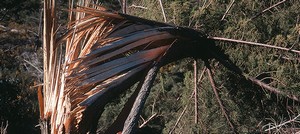The complexity of predicting wind damage
 Predicting how wind moves over forested landscapes can be challenging, according to Research Leader Dr John Moore. John recently attended a three day workshop at INRA* in France, on the mathematical modelling of wind damage in forests.
Predicting how wind moves over forested landscapes can be challenging, according to Research Leader Dr John Moore. John recently attended a three day workshop at INRA* in France, on the mathematical modelling of wind damage in forests.
“The workshop was an opportunity to assess the knowledge that currently exists about the damage winds cause to forests, particularly in Europe where it’s a major problem and one that’s likely to worsen under future climate change. The more we know, the better we can manage and prepare for.”
Predicting wind damage is a complicated process. Wind speed and direction change as the wind flows across a landscape and are also modified by the forest itself. Other elements such as the mechanics of wind-tree interactions, and the impacts of various management regimes on wind damage, add to the complexity.
“The amount of information we have on factors that affect risk is increasing, and will be further boosted with the use of new remote sensing technologies. These data are being incorporated into existing mathematical models.
“One of the key challenges remains our understanding of wind flow over forested landscapes. Knowing the pattern of wind over forests during storms is important in helping us understand the factors that contribute to wind damage and, therefore, how best to reduce the risk. It is also important for other aspects of forest management including pollen dispersal, spray management, wilding pine spread and fire risk.
“This workshop gave us all a chance to identify the knowledge gaps we need to address in future research, and a chance to see what other scientists are doing in this area and what can be applied here in New Zealand. I also came away with opportunities for future collaborations in the area of wind effects on growth and wood properties.”
* INRA is the French National Institute for Agricultural Research.
For further information
Contact Peter Clinton
